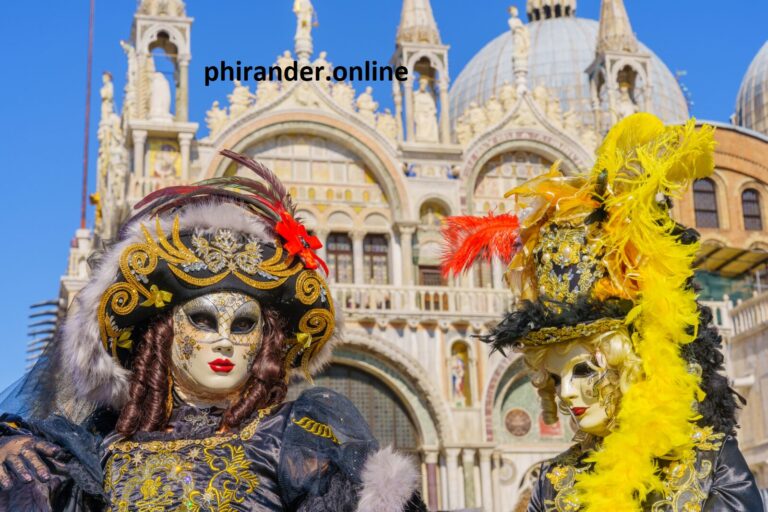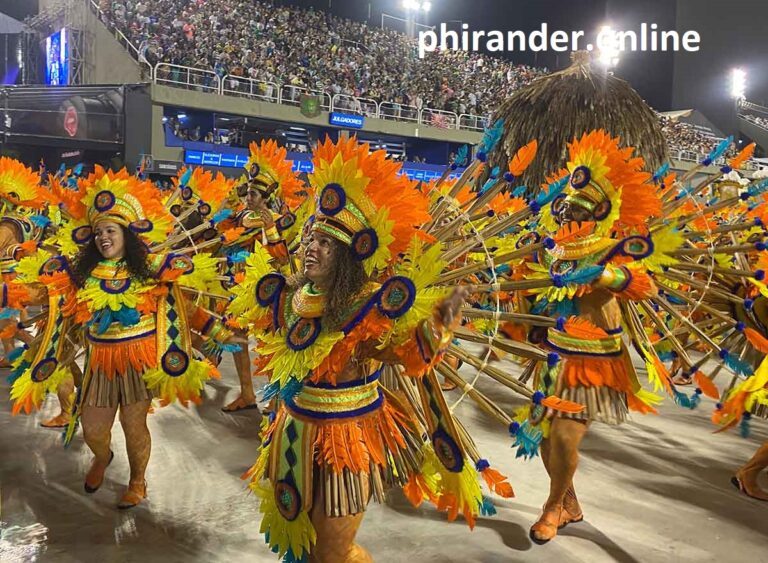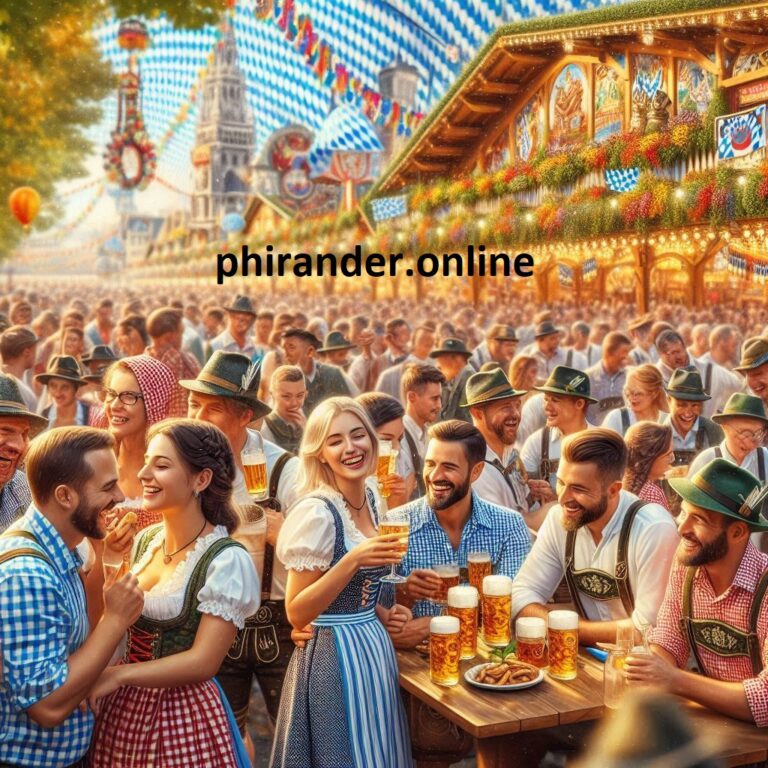Day of the Dead Mexico – A Vibrant Celebration of Life, Memory, and Ancestral Love 2025
Day of the Dead Mexico, The Day of the Dead, or Día de Muertos, is a deeply emotional and culturally rich festival celebrated primarily in Mexico, usually on November 1st and 2nd. Far from being a somber occasion, it is a joyous and colorful celebration of life and memory,
where families welcome back the spirits of their deceased loved ones for a brief, heartfelt reunion. This unique tradition blends indigenous Mesoamerican rituals with Catholic beliefs, creating a profound expression of love, remembrance, and the cyclical nature of life and death.
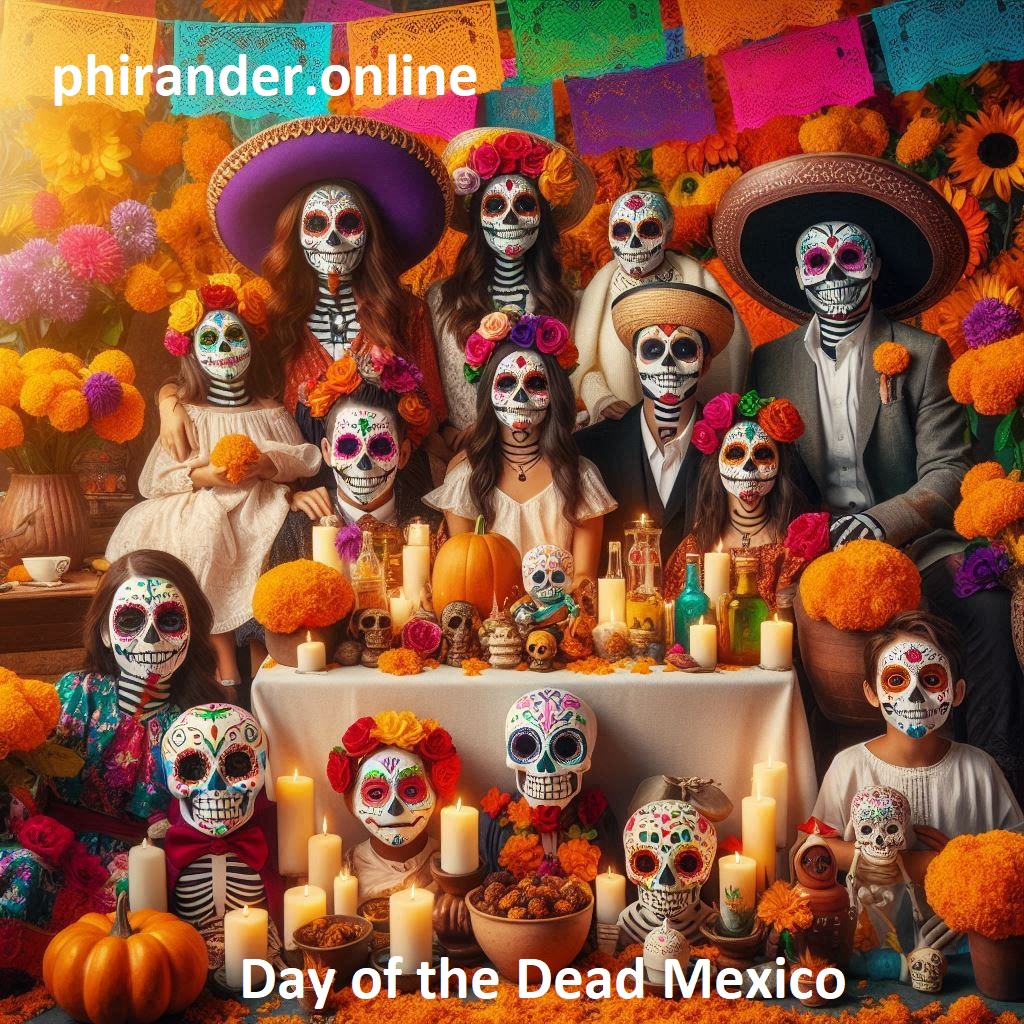
Roots in Ancient Traditions:
The origins of Día de Muertos can be traced back thousands of years to pre-Hispanic Mesoamerican cultures like the Aztec, Maya, and Toltec. For these civilizations, death was not an end but a continuation of life, a transition to another phase.
They honored the deceased through rituals that involved offerings of food, drink, and personal belongings. When the Spanish conquistadors arrived, they brought Catholicism and its All Saints’ Day and All Souls’ Day. Over centuries, these traditions merged, resulting in the contemporary Day of the Dead, a vibrant syncretic festival. Day of the Dead Mexico
Core Traditions and Profound Symbolism:
The heart of the Day of the Dead celebrations lies in the elaborate preparations and symbolic elements: Day of the Dead Mexico
Ofrendas (Altars): These are central to the celebration. Families meticulously build multi-tiered altars in their homes, adorned with photographs of the deceased, their favorite foods and drinks (like tequila, atole, or hot chocolate), fresh water, candles, and personal items.
These offerings are believed to nourish the spirits after their long journey back. Each tier often represents a different layer of existence or the journey of the soul. Day of the Dead Mexico
Calaveras (Skulls and Skeletons): Far from being morbid, skulls are a playful and universal symbol of life and death’s equality. Day of the Dead Mexico
Calaveras de Azúcar (Sugar Skulls): Intricately decorated sugar skulls, often bearing the name of the deceased (or even living friends as a playful gesture), are a quintessential offering.
La Calavera Catrina: A sophisticated, elegant female skeleton dressed in turn-of-the-century European garb, created by artist José Guadalupe Posada. She symbolizes that death ultimately triumphs over superficiality and vanity, and has become an iconic figure of the holiday.
Literary Calaveras: Satirical poems written for the occasion, often playfully mocking death or public figures. Day of the Dead Mexico
Cempasúchil (Marigold Flowers): These vibrant orange and yellow marigolds, known as “flowers of the dead,” are crucial. Their bright color and strong scent are believed to guide the spirits from the cemetery back to their family altars. Petals are often scattered to create a fragrant path.
Pan de Muerto (Bread of the Dead): A sweet, often anise-flavored bread decorated with bone-shaped pieces, representing the deceased. It’s a staple offering and a treat for the living.
Incense (Copal): Derived from tree resin, copal incense has been used in Mesoamerican rituals for centuries. Its fragrant smoke is believed to purify the air, cleanse the space, and help guide the spirits to the offerings. Day of the Dead Mexico
Cemeteries: Families visit cemeteries to clean and decorate gravesites, often with marigolds, candles, and offerings. Many spend the night by the graves, sharing food, drink, and music, creating a lively vigil filled with storytelling and laughter. Day of the Dead Mexico
Also Visit This
A Celebration of Connection, Not Grief:
Unlike many Western observances of death, Día de Muertos is not a day of mourning but a joyous affirmation of life and remembrance. It’s a time when the veil between worlds thins, allowing families to reconnect with their ancestors, reinforcing the belief that the departed are not truly gone as long as they are remembered.
The vibrant colors, music, food, and artistry reflect a unique cultural perspective on mortality – one that embraces death as a natural part of the human experience and celebrates the enduring bond of family across generations. Day of the Dead Mexico
The Day of the Dead was recognized by UNESCO in 2008 as an Intangible Cultural Heritage of Humanity, acknowledging its profound cultural significance and its role in reinforcing cultural identity. While its core traditions remain, the celebrations vary regionally across Mexico, each area adding its unique local flavor to this beautiful tribute. Day of the Dead Mexico
Día de los Muertos, Mexican traditions, Ancestor celebration, Mexico culture
Mexican skull art, Dia de los Muertos meaning, Day of the Dead traditions, How to celebrate Day of the Dead
Sugar skulls meaning, Calavera Catrina history Day of the Dead Mexico
Marigold flowers Day of the Dead Day of the Dead Mexico
What is the significance of marigolds in Day of the Dead? Day of the Dead Mexico
Day of the Dead vs Halloween differences Day of the Dead Mexico
How to make a Day of the Dead altar step by step
Traditional food for Day of the Dead Day of the Dead Mexico
Why do Mexicans celebrate Day of the Dead?
Meaning of Pan de Muerto symbolism
Symbolism of sugar skulls, Meaning of copal incense Day of the Dead Mexico
Day of the Dead rituals, UNESCO Intangible Cultural Heritage Mexico
Dia de los Muertos costumes buy, Mexico Day of the Dead tours, Authentic Mexican sugar skulls
Pan de Muerto recipe traditional Day of the Dead Mexico
To ensure this content (and the website it resides on) ranks highly for the targeted keywords, consider implementing the following features and strategies:
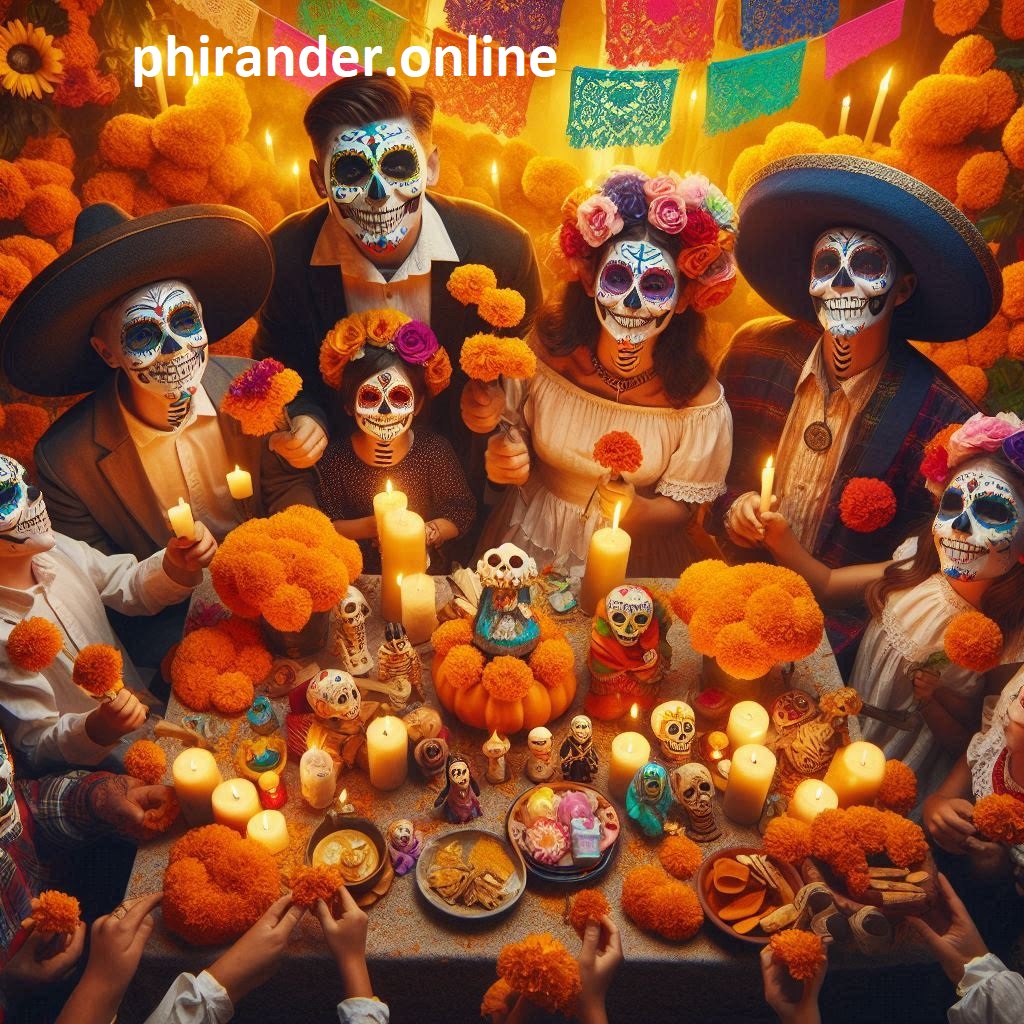
Comprehensive On-Page SEO:
Keyword Integration: Naturally weave all types of keywords (broad, phrase, long-tail) into the article’s title, headings (H1, H2, H3), meta description, introductory paragraphs, and throughout the body text. Avoid keyword stuffing.
Title Tag: Create a compelling title tag (e.g., “Day of the Dead (Día de Muertos) | Mexican Traditions, Masks & Altars | [Your Site Name]”) that includes primary keywords.
Meta Description: Write a concise and engaging meta description (around 150-160 characters) that summarizes the article and encourages clicks, including keywords.
Image Alt Text: Use descriptive alt text for all images that include relevant keywords (e.g., “Day of the Dead altar with marigolds and sugar skulls,” “Calavera Catrina illustration”).
URL Structure: Create clean, keyword-rich URLs (e.g., yoursite.com/day-of-the-dead-mexico-traditions).
High-Quality Content & User Experience (UX):
Depth and Accuracy: Ensure the article is well-researched, accurate, and offers comprehensive information.
Readability: Use clear, concise language. Break up text with headings, subheadings, bullet points, and short paragraphs.
Mobile-Friendliness: The website must be fully responsive and load quickly on all mobile devices. (Crucial for modern SEO).
Site Speed: Optimize images, leverage browser caching, and minify CSS/JS to ensure fast loading times. (Core Web Vitals).
Internal Linking: Link to other relevant pages on your site (e.g., articles about Mexican culture, specific crafts, travel guides) to improve site navigation and distribute link equity.
External Linking: Link out to authoritative external resources (e.g., UNESCO, reputable cultural institutions) for additional information and to build trust.
Rich Media Integration:
High-Quality Images: Include numerous high-resolution, visually appealing images of ofrendas, calaveras, parades, and general celebrations.
Videos: Embed YouTube videos (e.g., documentaries, short clips of celebrations) to increase dwell time and engagement.
Infographics: Create shareable infographics summarizing key facts or elements of an ofrenda.
Structured Data (Schema Markup):
Implement Article or BlogPosting schema markup to help search engines understand the content’s context, which can lead to rich snippets in search results (e.g., showing publication date, author, or images directly in SERP).
If applicable, consider Event schema for specific Carnival dates, or FAQPage schema for common questions.
Multilingual Strategy: Day of the Dead Mexico
Separate URLs for languages: Use distinct URLs for English (/en/day-of-the-dead) and Urdu (/ur/yom-e-murdegaan) versions.
hreflang Tags: Implement hreflang tags in your HTML to signal to search engines that you have content in multiple languages, targeting specific regions or languages. This prevents duplicate content issues and helps search engines serve the correct language version to users.
Engagement and Authority Building:
Social Sharing Buttons: Make it easy for users to share the content on social media platforms.
Comment Section: Allow users to leave comments and engage with the content, fostering a community. Day of the Dead Mexico
Backlink Acquisition: Develop a strategy to earn high-quality backlinks from authoritative websites (e.g., outreach to travel blogs, cultural sites, educational institutions). This is a strong ranking signal. Day of the Dead Mexico
Social Media Promotion: Actively promote the article on platforms like Facebook, Instagram, Twitter, and Pinterest, using relevant hashtags for both English and Urdu audiences.
Content Freshness & E-A-T (Expertise, Authoritativeness, Trustworthiness): Day of the Dead Mexico
Regular Updates: Review and update the content periodically, especially for dates (like the upcoming Carnival year) or new insights. Day of the Dead Mexico
Author Bio: If possible, include an author bio highlighting their expertise or connection to Mexican culture, enhancing credibility. Day of the Dead Mexico
By combining detailed, high-quality content with robust SEO practices and a thoughtful multilingual approach, the site can effectively rank for a wide array of keywords and attract a diverse global audience interested in the vibrant traditions of the Day of the Dead.
Day of the Dead Mexico – A Heartfelt Celebration of Ancestral Love
Day of the Dead Mexico, Día de los Muertos traditions, Mexican skull art, pan de muerto, ofrendas, marigold flowers, sugar skulls, Day of the Dead altars, cemetery vigils, best Day of the Dead celebrations, Day of the Dead 2024–25 Day of the Dead Mexico
1. What Is the Day of the Dead?
The Day of the Dead (Día de los Muertos) is a unique Mexican holiday celebrated on November 1–2, blending pre-Hispanic rituals and Catholic traditions to honor deceased loved ones
Rather than mourning, it’s a joyful remembrance, a time of reunion and celebration.
Mexican Day of the Dead, Día de los Muertos Mexico, Day of the Dead Mexico
1. ڈے آف دی ڈیڈ کیا ہے؟
ڈے آف دی ڈیڈ یا Día de los Muertos 1–2 نومبر کو منایا جاتا ہے، جس میں میمس–ہسپانوی رسموں اور کیٹولک اثرات کو ملایا جاتا ہے تاکہ مرحومین کو یاد کیا جائے ۔ یہ افسردگی نہیں—بلکہ محبت اور جشن کا ایک دلکش موقع ہے۔
کلیدی الفاظ: میکسیکو ڈے آف دی ڈیڈ، ڈیا ڈی لوس مویertos، ڈیڈ ہالیڈے
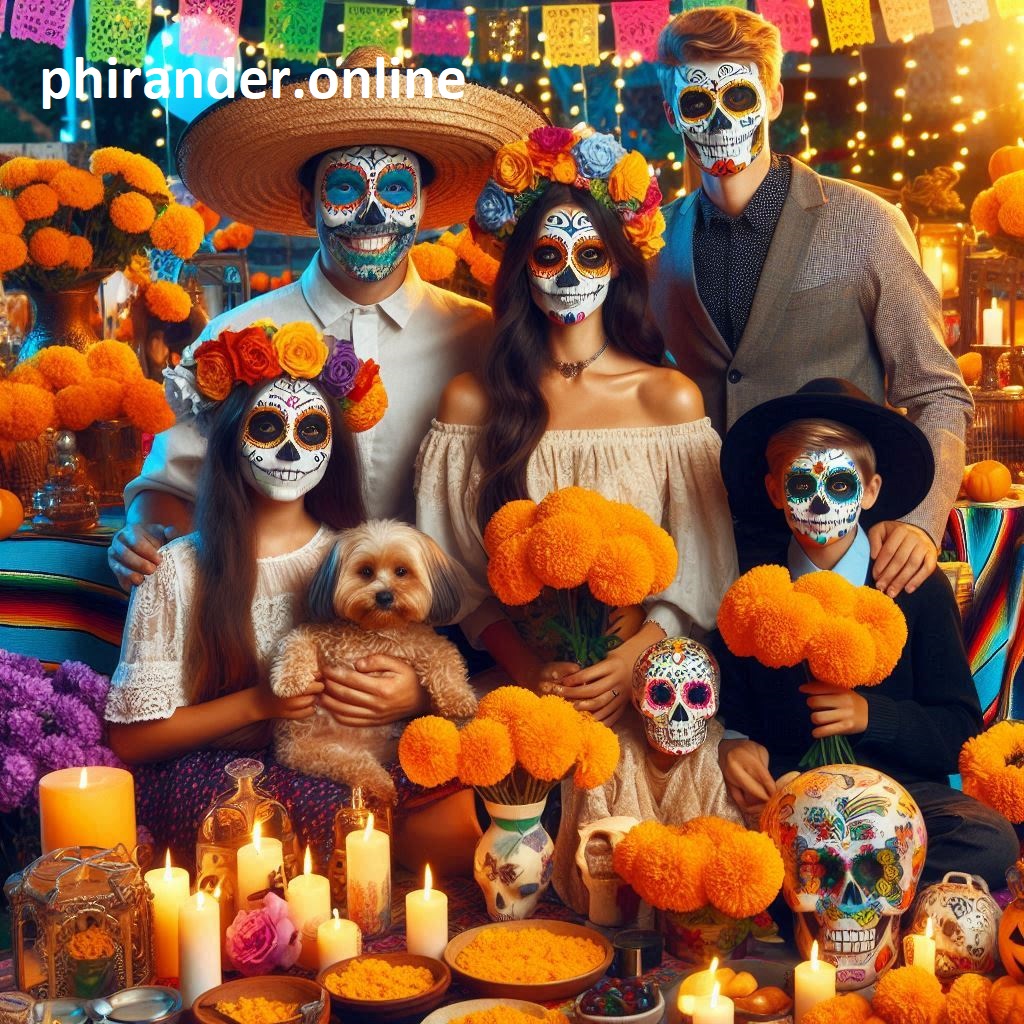
2. Ofrendas & Altars: Heart of the Celebration
Families build altars (ofrendas) in homes and at graves, decorated with marigolds, candles, incense, photos, and favorite foods of the departed
time.com Day of the Dead Mexico
britannica.com Day of the Dead Mexico
en.wikipedia.org Day of the Dead Mexico
Altars include pan de muerto and sugar skulls, offering spiritual nourishment
lonelyplanet.com
nationalgeographic.com
theculturetrip.com
Day of the Dead altars, ofrendas, marigold flowers, pan de muerto, sugar skulls
3. Cemetery Visits & Night Vigils
Families clean graves, lay marigold paths and food, and hold night vigils until dawn
time.com
thespruceeats.com
destinationlesstravel.com
Traditions include candles, papel picado banners, and calacas (skeleton decorations) symbolizing joy, not sorrow
dayofthedead.holiday Day of the Dead Mexico
theculturetrip.com Day of the Dead Mexico
reddit.com Day of the Dead Mexico
Day of the Dead cemetery vigil, marigold petals, papel picado
4. Skull Art & Calavera Culture
Calacas and calaveras (skeleton and skull figures) are decorated joyfully and worn as face paint during celebrations
thespruceeats.com
en.wikipedia.org
reddit.com
The iconic La Catrina is a symbol of social satire and elegance
dayofthedead.holiday
calaca Day of the Dead, calavera art, La Catrina, skull face paint
5. Foods & Drinks: Spiritual and Cultural Delights
Pan de muerto (sweet bread) is a staple, shaped with bone motifs and flavored with anise
blog.remitly.com
nationalgeographic.com
en.wikipedia.org
Offerings also include mole, pozole, atole, hot chocolate, and pulque, representing regional cuisines
nationalgeographic.com
pan de muerto recipe, Day of the Dead foods, traditional Mexican cuisine
6. Parades & Street Festivities
Major cities like Mexico City feature vibrant Catrina parades and Alebrije processions, adding color and creativity
en.wikipedia.org
destinationlesstravel.com
theculturetrip.com
Street art, sand tapestries, and public altars create a festival atmosphere
destinationlesstravel.com
Day of the Dead parade, Catrina parade, Alebrije festival, public altars
7. Symbolic Elements & Cultural Meaning
Marigolds guide souls with their color and scent
en.wikipedia.org
theculturetrip.com
beach.com
Candles light the spiritual path of the departed
thespruceeats.com
reddit.com
nypost.com
Copal incense purifies altars and carries prayers
beach.com
reddit.com
Salt, crosses, water, and offerings symbolize purification, direction, and sustenance
en.wikipedia.org
visit-mexico.mx
vogue.com
copal incense Day of the Dead, marigold petals, spiritual symbolism Day of the Dead
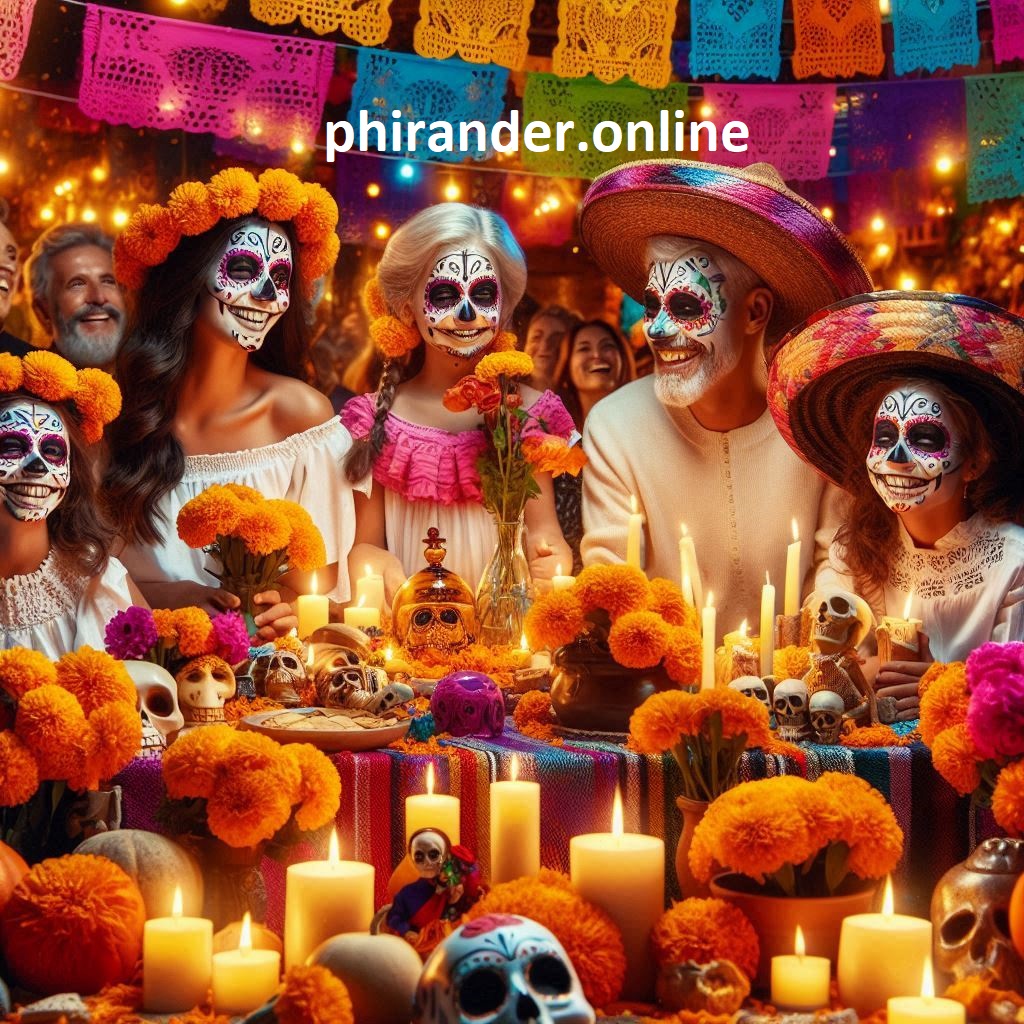
اردو میں خصوصیات اور کلیدی الفاظ
اہم تہوار اور سرگرمیاں
آلتار (اوفریندا): امیروں کی یاد میں سجائے جاتے ہیں۔
قبرستان کی صفائی اور قیام: موم بتیاں اور پھول قبر پر زندگی بھر لاتے ہیں۔
پابلیک پریڈ: کیٹرینا لباس اور الیبریجے منڈریل .
کھانے اور رسمیں
پان ڈی مویِرتو: مہکدار ہڈیوں کی شکل بریڈ .
میکسیکن پکوان: مولو، پوزولے، آٹولے اور ہاٹ چاکلیٹ .
علامتی عناصر
مرگولڈ کے پھول: روحوں کی راہ ہموار کرنے کے لیے .
موم بتیاں: روح کی رہنمائی کے لیے .
کپال دھوئیں: پاکیزگی اور دعا کی نمائندگی .
9. SEO & Ranking Suggestions
To ensure your article ranks high and engages readers:
Include primary keywords naturally in titles, H1, meta, and image alt texts.
Use long-tail phrases like “How to build a Day of the Dead altar”, “Best Day of the Dead celebrations in Mexico”, “pan de muerto recipe”.
Add images of altars, sugar skulls, and cemetery scenes with descriptive alt tags.
Internal linking: Connect to related topics like “Mexican traditions”, “Halloween vs Día de los Muertos”, or travel guides to Oaxaca and Mexico City.
10. Cultural Significance & Traveler Tips
UNESCO-recognized as Intangible Cultural Heritage
en.wikipedia.org
visit-mexico.mx
theculturetrip.com
foodandwine.com
nationalgeographic.com
destinationlesstravel.com
foodandwine.com
thespruceeats.com
nypost.com
Respect local customs: Always ask permission before photographing graves or private ceremonies.
Best destinations: Oaxaca, Michoacán, and Mexico City are known for authentic celebrations.
Plan ahead: Book tours and accommodations early as this season draws heavy tourism.
Day of the Dead travel guide, best places Day of the Dead Mexico, Day of the Dead Oaxaca, respectful tourism
Final Thoughts
The Day of the Dead is a moving celebration of life, death, and memory—where joy and mourning blend beautifully. Through skull art, altars rich with memory, and shared stories, families reaffirm their bonds across time. It is a festival unlike any other, deeply rooted in Mexican heritage and resonant with travelers seeking meaningful cultural engagement.
یوم مردگان (میکسیکو) – زندگی، یادداشت اور آبائی محبت کا ایک وائبرنٹ جشن
یوم مردگان، یا ڈیا دے لاس مورٹوس (Día de Muertos)، ایک گہرا جذباتی اور ثقافتی طور پر بھرپور تہوار ہے جو بنیادی طور پر میکسیکو میں، عام طور پر 1 اور 2 نومبر کو منایا جاتا ہے۔ یہ ایک افسردہ موقع ہونے کے بجائے، زندگی اور یادداشت کا ایک پُرجوش اور رنگین جشن ہے، جہاں خاندان اپنے پیاروں کی روحوں کا مختصر، دلی ملاپ کے لیے استقبال کرتے ہیں۔ یہ منفرد روایت قدیم میسوامریکی رسومات کو کیتھولک عقائد کے ساتھ ملا کر محبت، یاد اور زندگی و موت کے چکریی فطرت کا گہرا اظہار کرتی ہے۔
قدیم روایات میں جڑیں:
ڈیا دے لاس مورٹوس کی جڑیں ہزاروں سال پہلے قدیم میسوامریکی ثقافتوں جیسے ایزٹیک (Aztec)، مایا (Maya) اور ٹولٹیک (Toltec) میں پائی جاتی ہیں۔ ان تہذیبوں کے لیے، موت اختتام نہیں بلکہ زندگی کا تسلسل، ایک اور مرحلے میں منتقلی تھی۔ وہ فوت شدگان کو رسومات کے ذریعے عزت دیتے تھے جن میں خوراک، مشروبات اور ذاتی اشیاء کی پیشکش شامل تھی۔
جب ہسپانوی فاتحین آئے، تو وہ کیتھولک مذہب اور اس کے آل سینٹس ڈے (All Saints’ Day) اور آل سولز ڈے (All Souls’ Day) لے کر آئے۔ صدیوں کے دوران، یہ روایات آپس میں مل گئیں، جس کے نتیجے میں جدید یوم مردگان، ایک متحرک ہم آہنگی کا تہوار وجود میں آیا۔
بنیادی روایات اور گہرا علامتی معنی
یوم مردگان کی تقریبات کا مرکز تفصیلی تیاریاں اور علامتی عناصر ہیں
اوفرینڈاس (Ofrendas – قربان گاہیں): یہ جشن کا مرکزی حصہ ہیں۔ خاندان اپنے گھروں میں کثیر سطحی قربان گاہیں احتیاط سے بناتے ہیں، جنہیں مرنے والوں کی تصاویر، ان کے پسندیدہ کھانے پینے کی اشیاء (جیسے ٹکیلا، اٹول، یا گرم چاکلیٹ)، تازہ پانی، موم بتیاں، اور ذاتی اشیاء سے سجایا جاتا ہے۔ یہ پیشکشیں روحوں کو ان کے طویل سفر کے بعد واپس آنے پر غذائیت فراہم کرنے کے لیے سمجھی جاتی ہیں۔ ہر سطح اکثر وجود کی ایک مختلف پرت یا روح کے سفر کی نمائندگی کرتی ہے۔
کلاویراس (Calaveras – کھوپڑیاں اور ڈھانچے): خوفناک ہونے کے بجائے، کھوپڑیاں زندگی اور موت کی مساوات کی ایک شوخ اور عالمی علامت ہیں۔
کلاویراس دے ازوکار (Calaveras de Azúcar – شوگر اسکلس): خوبصورتی سے سجائی گئی شوگر اسکلس، جن پر اکثر مرنے والے کا نام (یا یہاں تک کہ زندہ دوستوں کا نام ایک شوخ اشارہ کے طور پر) لکھا ہوتا ہے، ایک لازمی پیشکش ہیں۔
لا کلاویرا کاترینا (La Calavera Catrina): فنکار جوس گواڈالپ پوساڈا (José Guadalupe Posada) کی تخلیق کردہ ایک نفیس، خوبصورت خاتون ڈھانچہ جو 19ویں صدی کے آخر کے یورپی لباس میں ملبوس ہے۔ وہ اس بات کی علامت ہے کہ موت بالآخر سطحی پن اور غرور پر غالب آتی ہے، اور چھٹی کی ایک مشہور شخصیت بن گئی ہے۔
ادبی کلاویراس: اس موقع کے لیے لکھی گئی طنزیہ نظمیں، جو اکثر موت یا عوامی شخصیات کا مذاق اڑاتی ہیں۔
سیمپاسوٹل (Cempasúchil – میریگولڈ پھول): یہ چمکدار نارنجی اور پیلے میریگولڈ پھول، جنہیں “مردہ پھول” کے نام سے جانا جاتا ہے، بہت اہم ہیں۔ ان کے روشن رنگ اور تیز خوشبو روحوں کو قبرستان سے ان کے خاندانی قربان گاہوں تک رہنمائی کرتی ہے۔ خوشبودار راستہ بنانے کے لیے اکثر پنکھڑیوں کو بکھیر دیا جاتا ہے۔
پین دے مورٹو (Pan de Muerto – مردہ کی روٹی): ایک میٹھی، اکثر سونف کے ذائقے والی روٹی جسے ہڈیوں کی شکل کے ٹکڑوں سے سجایا جاتا ہے، جو مرنے والے کی نمائندگی کرتی ہے۔ یہ ایک اہم پیشکش اور زندہ لوگوں کے لیے ایک لذیذ چیز ہے۔
لوبان (Copal – کاپل): درخت کے رال سے حاصل ہونے والا کاپل لوبان صدیوں سے میسوامریکی رسومات میں استعمال ہوتا رہا ہے۔ اس کے خوشبودار دھوئیں کو ہوا کو پاک کرنے، جگہ کو صاف کرنے اور روحوں کو پیشکشوں تک رہنمائی کرنے میں مدد دینے کے لیے سمجھا جاتا ہے۔
قبرستان: خاندان قبرستانوں میں قبروں کو صاف کرنے اور سجانے کے لیے جاتے ہیں، اکثر میریگولڈز، موم بتیوں اور پیشکشوں کے ساتھ۔ بہت سے لوگ قبروں پر رات گزارتے ہیں، کھانا، پینا اور موسیقی کا اشتراک کرتے ہیں، کہانی سنانے اور ہنسی سے بھری ایک پُرجوش جاگروتہ (vigil) تخلیق کرتے ہیں۔
غم نہیں، تعلق کا جشن:
موت کے بہت سے مغربی تہواروں کے برعکس، ڈیا دے لاس مورٹوس سوگ کا دن نہیں بلکہ زندگی اور یادداشت کی ایک پُرجوش تصدیق ہے۔ یہ ایک ایسا وقت ہے جب دنیاؤں کے درمیان پردہ پتلا ہو جاتا ہے، جس سے خاندانوں کو اپنے آباؤ اجداد سے دوبارہ جڑنے کا موقع ملتا ہے،
اس عقیدے کو تقویت ملتی ہے کہ بچھڑے ہوئے واقعی ختم نہیں ہوتے جب تک انہیں یاد رکھا جائے۔ روشن رنگ، موسیقی، کھانا اور فنکاری موت کے بارے میں ایک منفرد ثقافتی نقطہ نظر کی عکاسی کرتی ہے – جو موت کو انسانی تجربے کا ایک فطری حصہ سمجھتی ہے اور نسلوں کے پار خاندانی رشتے کے دائمی بندھن کا جشن مناتی ہے۔
یوم مردگان کو 2008 میں یونیسکو (UNESCO) نے انسانیت کے ایک غیر محسوس ثقافتی ورثے کے طور پر تسلیم کیا تھا، جو اس کی گہری ثقافتی اہمیت اور ثقافتی شناخت کو تقویت دینے میں اس کے کردار کو تسلیم کرتا ہے۔ اگرچہ اس کی بنیادی روایات برقرار ہیں، میکسیکو بھر میں علاقائی طور پر تقریبات مختلف ہوتی ہیں، ہر علاقہ اس خوبصورت خراج تحسین میں اپنا منفرد مقامی ذائقہ شامل کرتا ہے۔
یوم مردگان
ڈیا دے لاس مورٹوس (Dia de los Muertos)
میکسیکن روایات
آباؤ اجداد کا جشن
میکسیکو کی ثقافت
یوم مردگان کی قربان گاہیں
میکسیکن کھوپڑی کا فن
ڈیا دے لاس مورٹوس کا مطلب
یوم مردگان کی روایات
یوم مردگان کیسے منائیں
شوگر اسکلس کا مطلب
کلاویرا کاترینا کی تاریخ
میریگولڈ پھول یوم مردگان
یوم مردگان میں میریگولڈ پھولوں کی کیا اہمیت ہے؟
میکسیکو میں ڈیا دے لاس مورٹوس کا تجربہ کرنے کے لیے بہترین جگہیں کون سی ہیں؟
یوم مردگان اور ہالووین میں کیا فرق ہے؟
یوم مردگان کی قربان گاہ کیسے بنائیں؟
یوم مردگان کے روایتی کھانے
میکسیکن یوم مردگان کیوں مناتے ہیں؟
پین دے مورٹو کی علامت کا کیا مطلب ہے؟
ڈیا دے لاس مورٹوس کی تاریخ
شوگر اسکلس کی علامت
کوپال لوبان کا مطلب
یوم مردگان کی رسومات
یونیسکو غیر محسوس ثقافتی ورثہ میکسیکو
یوم مردگان کی سجاوٹ برائے فروخت
ڈیا دے لاس مورٹوس کے لباس خریدیں
میکسیکو یوم مردگان کے ٹورز
مستند میکسیکن شوگر اسکلس
پین دے مورٹو کی روایتی ترکیب
